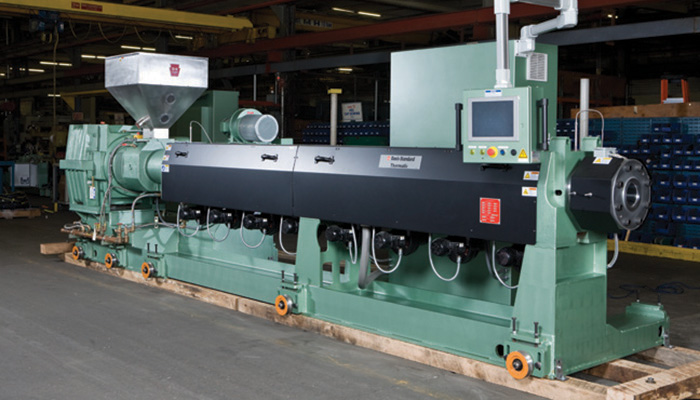Posted on 1st Feb 2025

Extruders play a critical role in industries like plastics, food, and pharmaceuticals, where continuous processes are key to producing high-quality products. In these applications, controlling the speed and power consumption of extruders can significantly impact both operational efficiency and product quality. A Variable Frequency Drive (VFD) is a crucial component that helps achieve these goals. By controlling the motor speed and torque of the extruder, VFDs offer a wide range of benefits, making them an indispensable part of modern extrusion systems.
A Variable Frequency Drive (VFD) is an electronic device that controls the speed, torque, and operation of an electric motor by adjusting the frequency and voltage supplied to the motor. This is particularly useful in systems requiring precise motor control, such as extruders, where consistency and accuracy in the speed and pressure of materials are essential.
In the context of extruders, VFDs adjust the speed of the motor powering the screw or auger, ensuring the right flow rate, temperature, and pressure for the material being processed. This provides greater flexibility in manufacturing processes and allows for better energy management.
Extruders typically run at a constant speed, which can lead to wasted energy if the motor operates under load conditions that don’t match the required output. A VFD optimizes motor performance by adjusting the motor's speed to match the precise needs of the extrusion process. This reduces energy consumption, as the motor only runs at the speed necessary for the current workload. In large-scale operations, the reduction in energy consumption can result in substantial cost savings.
VFDs allow for fine control over the extruder’s motor, making it possible to maintain a consistent output and pressure. This is especially important in applications like plastic extrusion, where slight variations in speed can affect the uniformity and quality of the final product. By providing precise control over motor speed and torque, VFDs contribute to more consistent extrusion results, minimizing defects and improving product quality.
Extruder motors that run at a constant high speed can experience significant wear over time, especially if the load varies. A VFD ensures that the motor runs at an optimal speed for each phase of the extrusion process, reducing mechanical stress. This leads to less wear on components such as bearings, shafts, and screws, extending the lifespan of the equipment and reducing maintenance costs.
With the ability to adjust motor speed in real-time, operators gain more control over the extrusion process. The VFD can respond to changes in material characteristics, such as viscosity, temperature, or pressure, and adjust motor performance accordingly. This dynamic control allows for quicker adaptation to changes in production requirements, reducing the chances of defects and improving overall process reliability.
One of the challenges in extrusion systems is the mechanical stress placed on motors and drives during startup and shutdown. Traditional systems may cause abrupt changes in motor speed, leading to high inrush currents, mechanical shocks, and potential damage to the system. VFDs provide a smooth start and stop by ramping motor speed up or down gradually. This not only reduces the risk of damage but also minimizes electrical surges, contributing to longer equipment life.
In extrusion processes, temperature plays a crucial role in ensuring the quality of the final product. Variations in speed and pressure can lead to inconsistent heating or cooling of the material. By using a VFD, the motor speed can be adjusted to maintain consistent throughput, leading to more stable temperature control throughout the process. This helps prevent issues such as overheating or underheating, which can lead to defects.
While VFDs may require an initial investment, the long-term benefits they offer far outweigh the upfront costs. Reduced energy consumption, lower maintenance requirements, and fewer operational disruptions contribute to a significant reduction in overall operational costs. Additionally, the improved product quality and consistency can lead to greater customer satisfaction and potentially higher sales.
Extruders typically consist of a motor that drives a screw to push material through a heated barrel. The material is then shaped, cut, or processed according to the desired specifications. A VFD is integrated into the motor control system, where it regulates the motor's speed based on real-time feedback from sensors monitoring parameters like pressure, temperature, and torque. By adjusting the frequency and voltage supplied to the motor, the VFD ensures the extruder operates at an optimal speed for the specific material and product being processed.
Motor Compatibility: Ensure the VFD is compatible with the type and rating of the motor used in the extruder system.
Process Requirements: Depending on the application, the VFD should support the required motor speeds, torque demands, and feedback control loops necessary for the extrusion process.
Energy Efficiency Features: Look for VFDs with built-in energy-saving features such as power factor correction and energy consumption monitoring.
Environmental Conditions: Consider factors such as temperature, humidity, and dust when selecting a VFD, especially in harsh industrial environments.
Ease of Integraon: The VFD should be easy to integrate with existing control systems and automation platforms used in the extrusion line.ti
The integration of a Variable Frequency Drive into extruder systems is an effective solution for enhancing operational efficiency, improving product quality, and reducing energy costs. By providing precise control over motor speed and torque, VFDs allow for smoother operations, extended equipment life, and more consistent results. As industries continue to demand higher efficiency and precision in manufacturing, the use of VFDs in extrusion systems will remain an essential tool for optimizing performance and achieving competitive advantages.
Whether you're seeking to improve energy savings, reduce maintenance costs, or maintain consistent output, a VFD for your extruder is a smart investment that pays dividends in the long run.